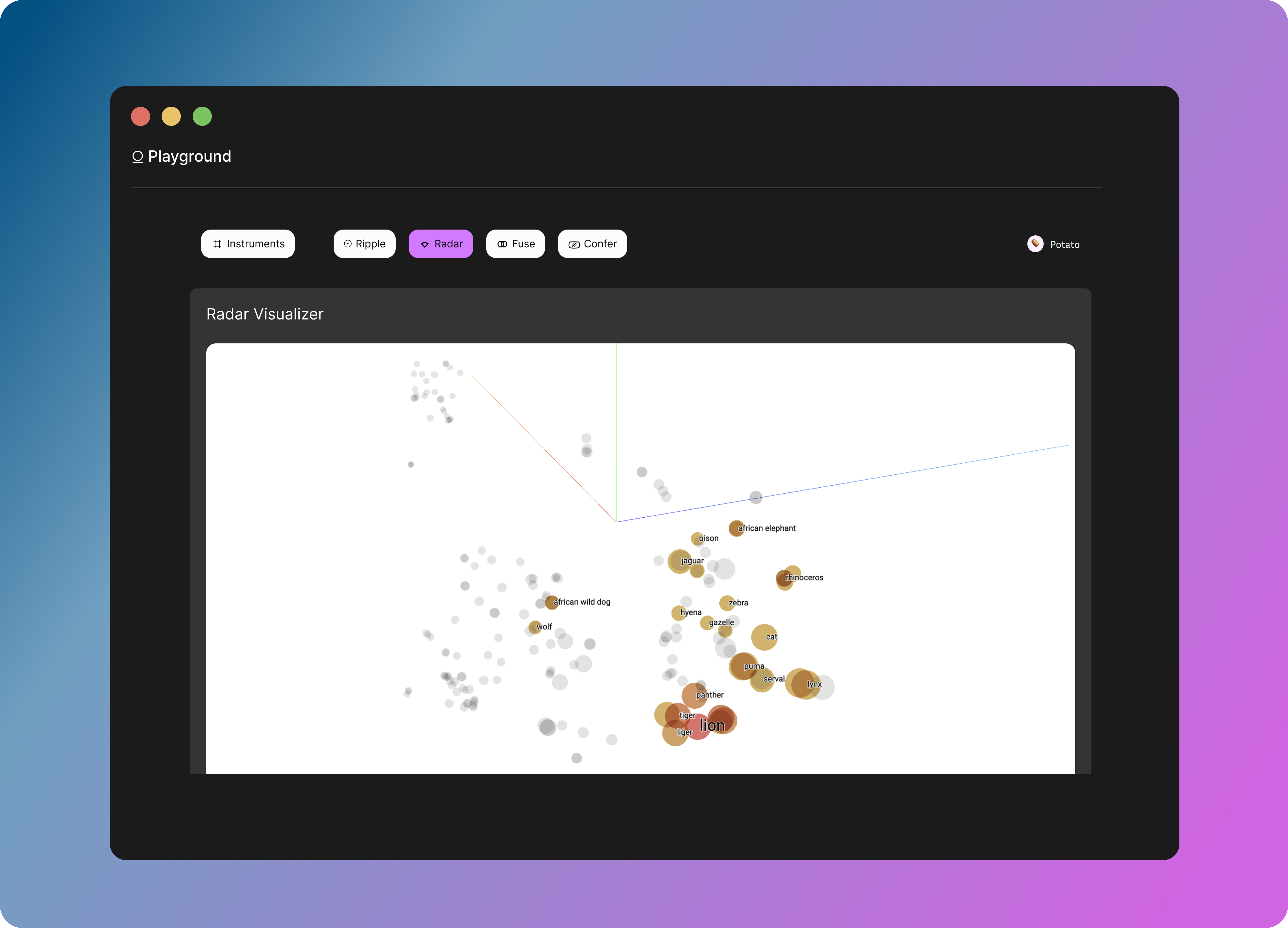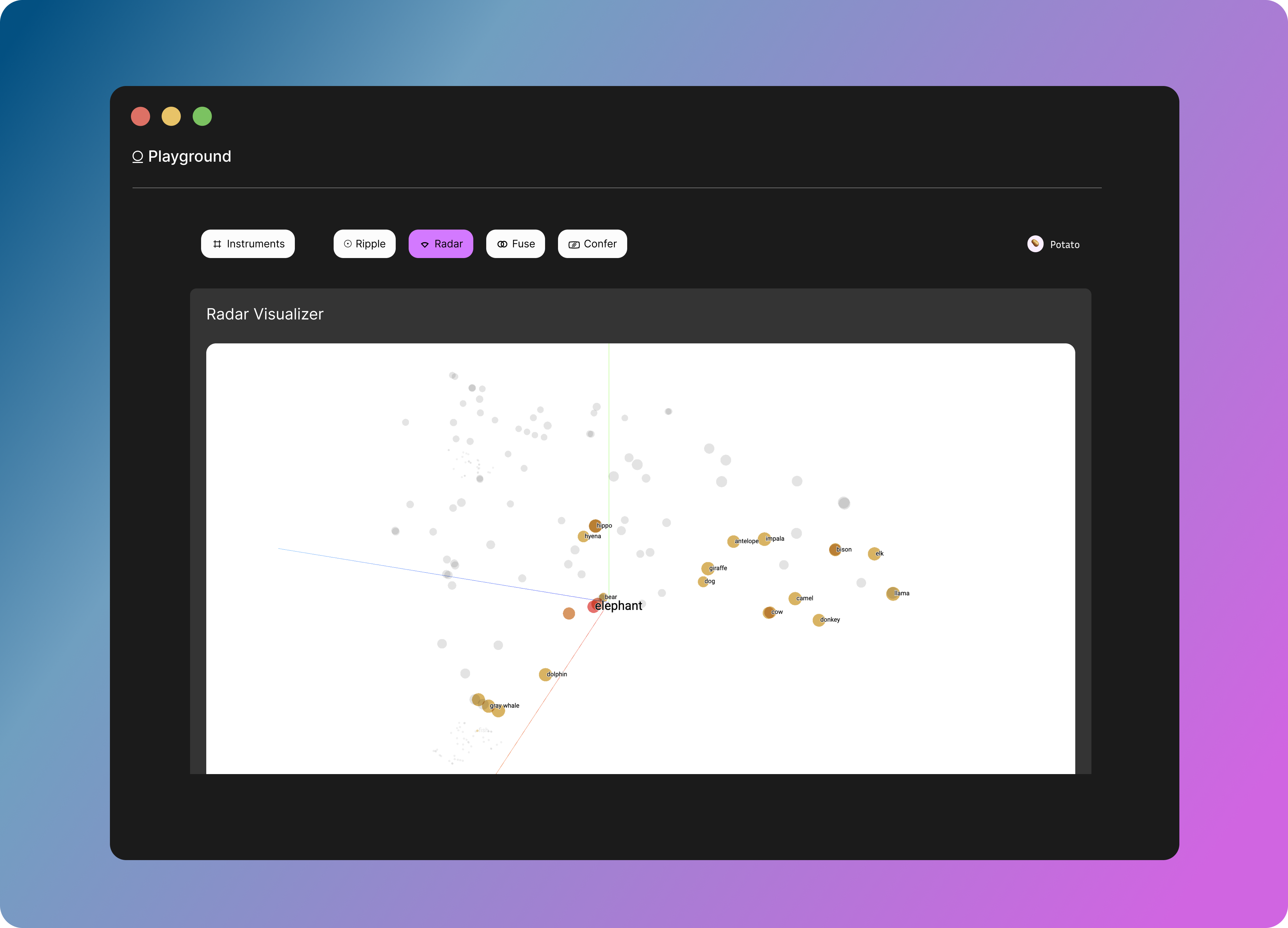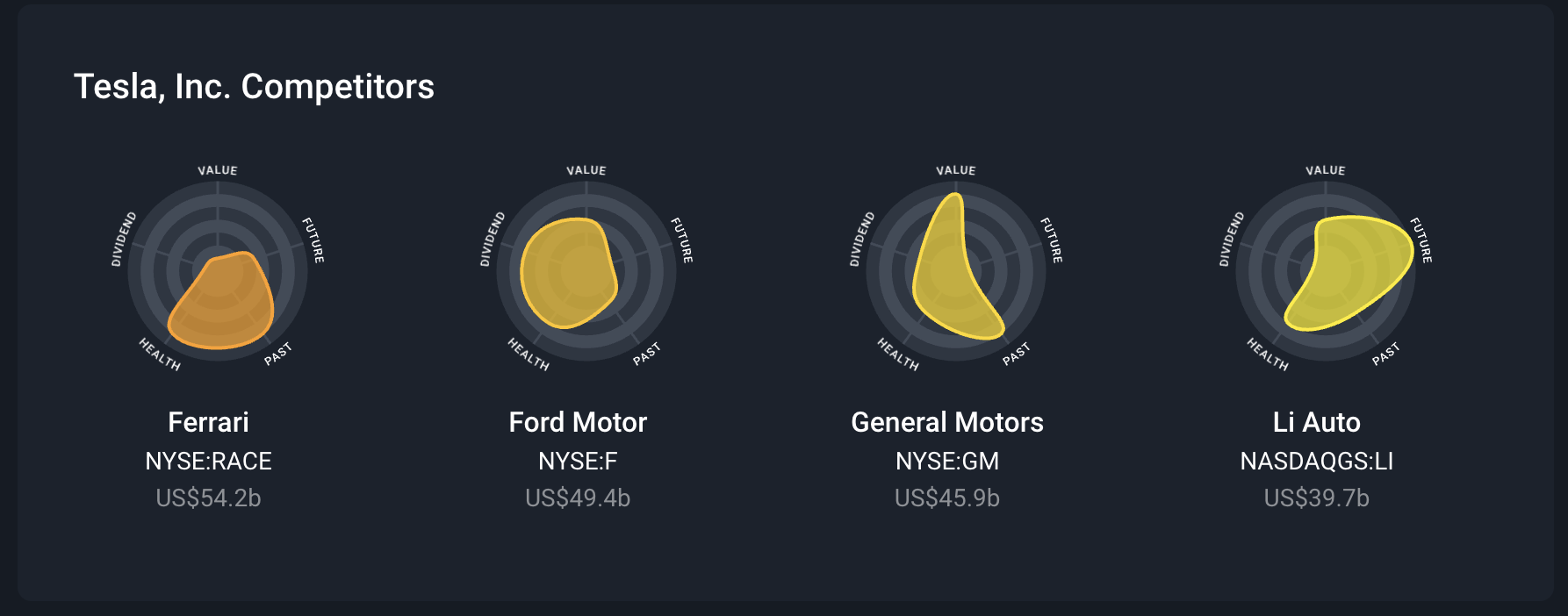Just Launched: Telescope Radar. Unpacking Investor Personas with AI

Financial services have struggled to truly understand their customers beyond superficial categorizations. Investors are often simply organized into generic risk profiles or market sectors, limiting the personalization and depth of discovery. Recent advances in natural language processing allow a more nuanced analysis of how individual investors view markets based on the narratives they use to describe their holdings.
Our new product, Telescope Radar, showcases how modern AI can map portfolios using a conceptual understanding of language to uncover richer investor personas without rigid labels. This empowers more intelligent recommendations that resonate with each investor’s unique perspectives and interests. Radar brings nuance, insight, and depth to investor analysis - unlocking a richer investment discovery experience and deeper customer insights.
Thinking in Embeddings
To understand Telescope Radar, it helps to think visually. Let’s start with a simple example.
Imagine organising Animal species by their characteristics (physical makeup, diet, behavior, habitat etc), organize them in a multi-dimensional embedding model and then plot them on a 3d space:
 Animals compared by characteristics; Lions and Panthers are similar.
Animals compared by characteristics; Lions and Panthers are similar.
As you can see a Lion is most similar to a Panther, followed by a Tiger due to their physical makeup - the product that they are and the service that they supply.
Thinking with Behaviors
Moving beyond physical characteristics, let’s look at some examples of animals that may be similar physically but have very different behaviors, let’s look at how they think:
Similar characteristics, dissimilar in behaviors:
Dolphins and Sharks: These two species are similar in their physical characteristics, both being large marine creatures with streamlined bodies for efficient swimming. However, their behaviors/personas are quite different. Dolphins are known to be highly social, intelligent, and playful creatures. They have complex social structures and often engage in cooperative hunting. On the other hand, most species of sharks are solitary predators. They are not known to form social bonds like dolphins do, and their intelligence, while not insignificant, is not usually compared to that of dolphins.
Similar behaviors, dissimilar characteristics:
Elephants and Dolphins: These species are vastly different in size, habitat, and physical traits. Elephants are large land mammals while dolphins are smaller ocean-dwelling mammals. However, both exhibit high intelligence, complex social bonds, and the ability to mourn their dead. They display advanced problem-solving skills - using tools like branches or sponges to accomplish goals. So while elephants and dolphins appear quite different, their advanced cognitive abilities and social behaviors reveal profound underlying similarities. This shows how contrasting physical traits can mask shared personas when analyzing beyond superficial characteristics.
 Animals compared by the way they think; Elephants, Bears and Dolphins are similar.
Animals compared by the way they think; Elephants, Bears and Dolphins are similar.
Behaviors in Stocks
Just as dolphins and sharks have vastly different implications despite physical similarities, stocks with comparable attributes can play very different roles in an investor’s portfolio when considering their narratives and appeal. Personas powerfully augment simplistic characteristics to unlock richer, human-centric insights.
AI allows us to uncover the same insights for investors. Rather than relying on superficial categories, we can map portfolios based on how companies act and how investors think about markets.
Our new product Telescope Radar embeds portfolios based on a deep analysis of the narratives and language used by investors to describe their holdings. This creates a conceptual map unlocking richer investor personas. Telescope Radar embeds investor portfolios into a conceptual space using natural language processing. The distance between two points in this space reflects portfolio similarity based on deep semantic analysis.
This approach unlocks new insights:
- Discover which peers have truly similar perspectives, without imposing labels.
- Quantify subtle differences between portfolios - e.g. different takes on similar themes.
- Granularly diagnose weaknesses and gaps for smarter diversification.
- Offer personalized recommendations that resonate with each investor’s unique persona.
Traditional techniques only scratch the surface of how people relate to markets. But Radar finally brings Nuance, Insight, and Depth to investor profiling - unlocking the next generation of intelligent portfolio management.
Single Stock Recommendations
Tesla vs Ford
On the surface, Tesla and Ford seem cut from the same cloth. Both manufacture vehicles. Websites such as Yahoo Finance, MarketWatch, Bloomberg, Simply Wall St contain a ‘similar to’ or ‘competitor’ sections on display when viewing the single stock of Tesla.

But when we look closer at this single stock, Tesla, glaring differences emerge:
- Tesla represents a new era of electrification and autonomy. Ford relies on legacy combustion models.
- Tesla is emissions focused. Ford offers stability as an old-guard industrial.
- Tesla has an aspirational brand focused on luxury and performance that attracts early adopters. Ford has an everyday value brand appealing to the mass market.
- Tesla is a volatile, high-growth tech stock. Ford offers stability as an old-guard industrial.
- Tesla attracts risk-seeking investors. Ford appeals to value-focused income investors.
- Tesla represents a Silicon Valley, software-led, project-driven culture. Ford has a traditional industrial Midwest manufacturing culture.
The companies share a sector, but attract very different investors for different reasons and have nuances that collectively vary them well beyond the product on offer. Traditional similarity matching fails to capture these nuances.
Recommendations by Goods & Service
Let’s begin by querying Telescope Radar with “TSLA” by simply considering the “goods & services”.
The results:
- General Motors Company
- Ford Motor Company
- Toyota Motor Company
- Honda Motor Company
Recommendations by Product on Offer
Now again, let’s run Telescope Radar but this time requesting a recommendation based on the “product on offer” (i.e. pure EV companies)
The Results:
- Rivian Automotive Inc
- NIO Inc
- Fisker Inc
- LI Auto Inc
Whilst GM is progressing towards EV at a rapid pace, only 2.3% (Q2, 2023) of their revenue is from EV sales.
Recommendations by Investor Interest
Finally, let’s ask for recommendations using “investor interest” (an investor that has motivations towards investing in Tesla, what are they also likely to buy):
The Results:
- Block Inc
- Palantir Technologies
- Robinhood Markets
- DraftKings
Portfolio based Recommendations
Analysis of the true nature of a business or the persona of an investor can move well beyond a single stock. To understand how Telescope Radar can step beyond siloed sectors and narrow similarity to provide expanded recommendations, consider an investor who owns:
- Tesla (TSLA)
- Nvidia (NVDA)
- Robinhood (HOOD)
A legacy engine might just recommend more auto, chip, or fintech stocks. But Telescope Radar analyzes the underlying context of the investment rationale which may be innovation, disruption, and momentum themes. This produces a much more insightful recommendation.
Based on the “product on offer” match, Telescope Radar suggests:
- AMD (AMD) - an innovator in chips competing with NVDA
- Rivian (RIVN) - an electric vehicle maker rivaling TSLA
- SoFi (SOFI) - a fintech appealing to young investors
- AMD (AMD) - an innovator in chips competing with NVDA
Using “investor interest” matching, the result is a diversified set of stocks that are closely aligned in terms of potential investor interests:
- Palantir (PLTR) - for its disruptive data analytics
- SoFi (SOFI) - a fintech appealing to young investors
- Rivian (RIVN) - an electric vehicle maker rivaling TSLA
- Alphabet (GOOGL) - a tech giant powering innovation
- Nextera Energy (NEE) - a clean energy stock
- Lockheed Martin (LMT) - an aerospace and defense name
- CRISPR Therapeutics (CRSP) - a biotech unlocking genomic potential
(Note: These results were filtered)
VP of Engineering at Telescope, Andrew Bucknall explains: “Our AI approach builds holistic personas by analyzing language. This enables more organic, human-like understanding compared to legacy systems.”
The future of Recommendations
Financial services have seen no shortage of AI hype. But Radar demonstrates how language models create real, tangible value for publishers, brokerages and investors when applied thoughtfully. It provides a blueprint for how AI can augment human intelligence, not replace it.
These narratives shape investor perceptions and relationships with stocks. By analyzing portfolios based on these underlying perspectives and personas, we can unlock deeper insights compared to traditional classification by sectors, themes, or risk profiles.
Behaviors and personalities reflect how investors think and relate to markets on a more fundamental level. Characteristics are descriptive, but personas are explanatory. They help us understand motivations and values that drive real-world decision making.
At Telescope, our goal is to keep pioneering these innovations. To learn more about how AI is transforming finance, connect with the team at Telescope.